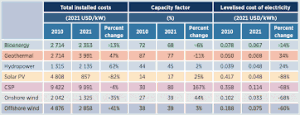From the Coal Cost Crossover 3.0 dated January 28, 2923
NEARLY ALL U.S. COAL PLANTS ARE MORE EXPENSIVE THAN NEW CLEAN ENERGY
Coal powered the United States economy for decades, but that era is fast coming to a close. The cost of new clean energy technologies has plummeted over the past decade while coal costs have stayed flat or risen, creating a “cost crossover” between coal and renewables in 2020 when renewables provided more power to our grid than coal for the first time.
Our first Coal Cost Crossover report, based on the 2017 coal fleet, found 62 percent of U.S. coal capacity was more expensive to run than to replace with renewables, while our second, based on the 2019 coal fleet, found 72 percent of capacity more expensive than renewables.
The Inflation Reduction Act (IRA) accelerates this coal cost crossover. First, the IRA extends and expands the investment and production tax credits, significantly reducing wind and solar costs. Second, IRA funding for loan guarantees to refinance fossil fuel power resources and reinvest in new clean energy infrastructure, creates an economic opportunity to pay down coal debt and attract investment in new renewable resources.
Our third Coal Cost Crossover report analyzes 2021 costs for 210 coal plants across the country (totaling 220 gigawatts of coal capacity), comparing them to actual costs for solar and wind in 2021, and incorporating the new tax credits. We find 99 percent of plants (209 out of 210) are more expensive to run than replacing their generation capacity with either new solar or new wind. The savings of using renewables would be significant: The cost of either new wind or solar is at least 30 percent cheaper than the cost of running more than three-quarters of existing U.S. coal plants.
LOCAL RENEWABLES CAN DRIVE $589 BILLION INVESTMENT IN COAL COMMUNITIES
The IRA created a bonus “energy communities” tax credit for building projects in areas that have historically depended economically on the fossil fuel industry. To capture the potential of this tax credit to generate new clean energy investment for these communities, we compared the cost of building new wind and solar resources within 30 miles of each coal plant to the cost of running the existing coal plant.
For 199 of the 210 coal plants, local solar replacement is less expensive than existing coal, and for 104 plants, local wind is less expensive. For 89 plants, both local wind and local solar were cheaper than coal, indicating a clean energy portfolio including local wind and solar is a viable replacement option for those plants, while providing additional grid reliability value.
Between solar and wind, our study finds replacing 204 coal plants with new local clean energy would generate up to $589 billion in new investment in energy communities across the country.
Local replacement of coal plants with renewables offers several advantages, including preserving tax revenue and creating jobs in energy communities, qualifying projects for IRA-authorized funding and loans, and potentially avoiding the need to build new transmission to connect to the grid by using existing coal plant infrastructure.
PAIRING LOCAL RENEWABLES WITH STORAGE PROVIDES ADDED RELIABILIY
We also evaluated the cost of adding four-hour battery storage with local solar to provide additional reliability value and in some cases, higher market profitability. We find that the potential savings from switching from coal to local solar can finance 137 GW of four-hour battery capacity across the coal fleet, or more than 60 percent of the capacity of all 210 coal plants we studied. While reliability does not necessarily depend on adding storage, adding some amount of storage can help integrate renewables and accelerate clean energy adoption.
For more than a third of the coal plants we studied, we find that in addition to replacing the electricity generation with local solar, 80 percent or more of the plant’s capacity can be replaced with four-hour batteries at a combined cost that is still lower than the cost of operating the coal plant. For the remaining coal plants, the percentage of capacity that can be economically replaced is still quite significant: Savings from renewable generation could fund battery storage at more than 50 percent plant capacity at 135 plants.
POLICIES TO SPEED THE COAL TO CLEAN TRANSITION
The economics are clear: Solar and wind offers much cheaper power compared to coal and without compromising the reliability of our electricity system. However, policymakers must act to unlock the cost savings, redevelopment, and human health benefits for coal communities. Several policies can hasten the coal-to-clean transition:
• Regulators should:
o Encourage utilities to utilize IRA financing programs from the Departments of Energy and Agriculture.
o Enable competitive resource procurement.
o Require reassessment of any utility investment plan, including integrated resource plans and market-
based solicitation for renewable supply, completed prior to IRA as renewables costs will be out of date.
• State legislatures and energy offices should plan and fund a coal community economic transition, where local
clean energy resources anchor a more expansive economic transition plan.
• Regulators and system operators should:
o Improve methods to assess reliability and resource adequacy that reflect the reliability value of renewable portfolios and value the reliability attributes of a high-renewable grid.
o Update interconnection study rules to leverage existing coal plant interconnection rights to speed grid connection processes for local renewable replacement resources.
#######+++++++#######+++++++#######
See Also: Most Renewables Now Cheaper Than Cheapest Coal – CleanTechnica, July 21, 2022
https://cleantechnica.com/2022/07/21/most-renewables-cheaper-than-cheapest-coal-in-g20/

